philae
Latest
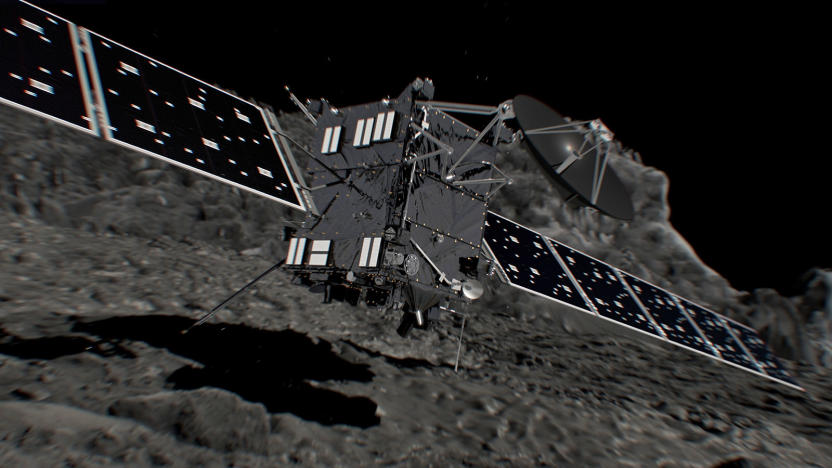
Watch the Rosetta probe fall into its death spiral this Friday
On September 30th, the European Space Agency's (ESA) Rosetta probe will cap off its 12-year career surveying Comet 67P (aka Churyumov-Gerasimenko) by slowly descending to its surface. There the spacecraft will join its lander Philae, given up for lost and recently re-found, before losing all power upon landing. You can watch Rosetta's last dance with its comet partner on NASA TV and elsewhere online, both broadcasting the probe's end with analysis and commentary on Friday from 6:15 AM until 8 AM ET.
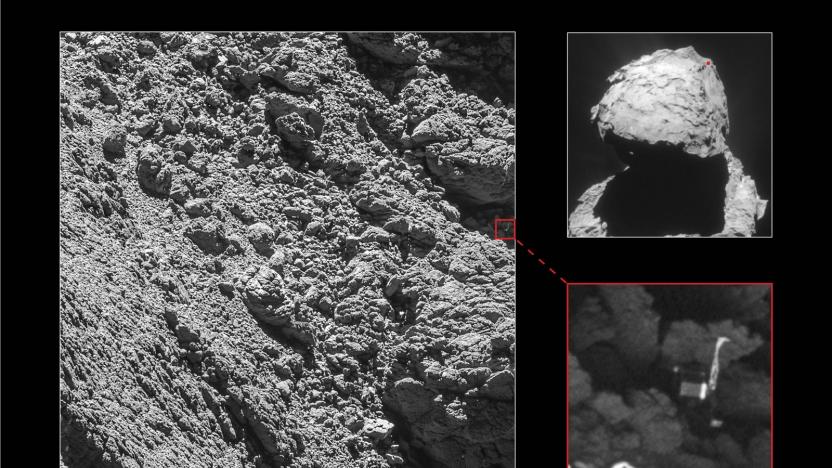
Rosetta probe belatedly finds the Philae comet lander
You have to sympathize with the European Space Agency. It's less than a month away from crashing its Rosetta probe into its host comet, and it just found the Philae comet lander -- you know, the machine the mission team stopped trying to contact back in July. Photos show that the lander get stuck in a dark crack on the comet in a position that prevents it from getting sunlight, revealing exactly why it went to sleep after a mere three days of activity. The ESA has had a general idea of where Philae was, but the low-resolution photos available before now made it hard to pinpoint the machine's location.
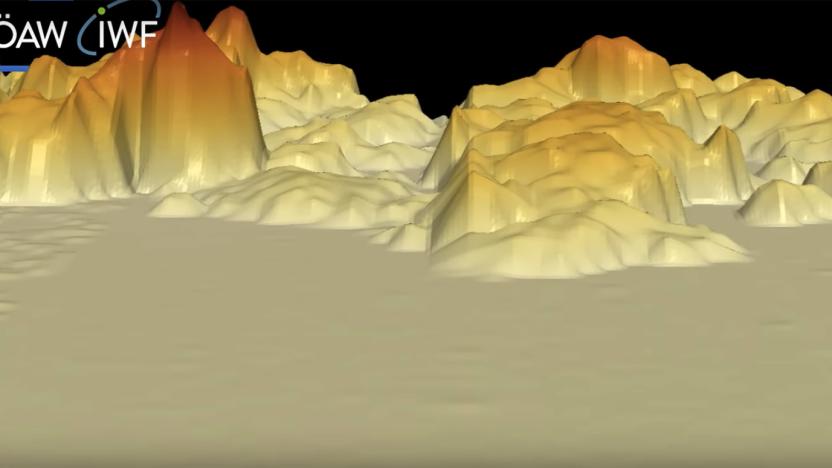
Rosetta 3D images comet dust before it bids farewell
Rosetta's scientists are doing every bit of science they can before the European Space Agency crashes the probe into the comet it's been studying. In fact, the spacecraft's Micro-Imaging Dust Analysis System (MIDAS) has just analyzed dust samples Rosetta collected from Comet 67P/Churyumov-Gerasimenko from November 2014 to February 2015. Mark Bentley, MIDAS' principal investigator, explained that "we need to understand the structure of the smallest grains and how they are built" to understand how comets are formed. Comet dust could also shed light on the beginnings of our solar system.

Comet lander Philae says goodbye as communications are cut
Farewell Philae, it was a short but wild ride. In February, mission controllers said goodbye to the comet lander, but kept comms open with mother ship Rosetta on the slight chance it might wake up. "It's cold & dark on #67P ... but I won't give up just yet," Philae tweeted hopefully. However, controllers elected to cut Rosetta's "ESS" lander radio at 5AM ET today to preserve its precious remaining power.
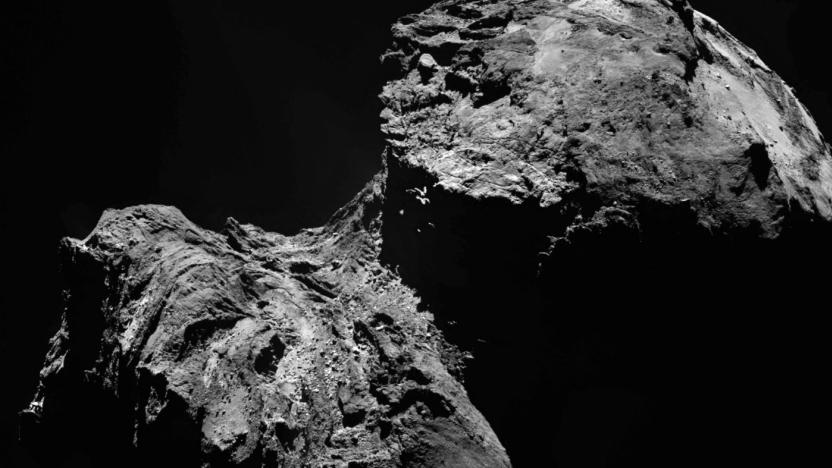
Rosetta will crash into its comet and die on September 30th
Farewell, young spacecraft. The European Space Agency's Rosetta probe has been surveying Comet 67P (or Churyumov-Gerasimenko) for the past 12 years, and on September 30th it will crash into the space rock and end its mission. Rosetta is nearing the orbit of Jupiter, which means it's running short on solar power and bandwidth required to downlink necessary data.
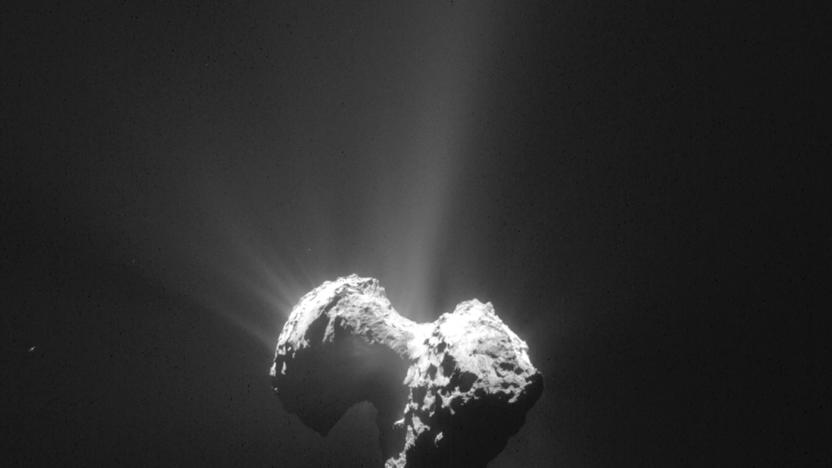
Rosetta finds key building blocks of life in comet dust
The amino acid glycine, one of the key building blocks of life as we know it, has been found in the "fuzzy atmosphere" of comet 67P Churyumov-Gerasimenko, the European Space Agency announced today. The findings mean it is likely the glycine was carried through space on the surface of the comet.

The After Math: Love is in the air
Scientists just confirmed the existence of gravitational waves -- actual ripples in the fabric of spacetime -- but who cares about unravelling the secrets of the universe, Valentine's Day is coming up. To pay respects to the most high holy of made-up bullshit holidays, here are seven of the most heart-string-tugging posts from the last week.

Philae mission team says goodbye to the comet lander
The mostly quiet Philae comet lander appears to be silent for good. German space agency DLR announced today that it would no longer attempt to send commands to the unit. "Unfortunately, the probability of Philae re-establishing contact with our team at the DLR Lander Control Center is almost zero... it would be very surprising if we received a signal now," said project manager Stephan Ulamec. The news isn't too unexpected as the German Aerospace Center revealed last month that the latest attempts to revive the lander had been unsuccessful.

Philae comet lander has likely gone silent for good
If you were hoping for a happy ending to the Philae comet lander's frequently perilous adventures, you might be disappointed. The German Aerospace Center reports that a last-ditch attempt at contacting the lander has so far gone without a response. Either it doesn't have enough power to follow through, or it didn't get the commands in the first place. There will still be "contact opportunities" until January 21st (when the Rosetta spacecraft flies to the comet's southern hemisphere), the Center says, but it's not expecting to hear back.

ESA makes an easy-to-view archive of new Rosetta comet images
The Rosetta probe has finally beamed back the photos (among other data) it took of 67P/Churyumov–Gerasimenko, as it flew within just 19 miles of the comet's surface. They were captured by the probe's main imaging system called OSIRIS, which is comprised of one narrow-angle and one wide-angle camera, from June 20th to September 16th, 2014. The spacecraft has gone closer to the comet since then, but the photos illustrate what the probe was seeing as it approached the celestial body.

Philae delivered crucial comet data despite its bumpy landing
Philae had a bumpy landing on the 67P/Churyumov-Gerasimenko comet last November, but that didn't stop it from relaying some important data back to Earth. Papers published in the journal Science reveal how scientists, using the data collected by Philae's onboard instruments, have been able to identify the internal structure of the comet, its daily fluctuations in temperature and organic compounds that could help support life.

Philae comet lander goes silent once again
It looks like the Philae comet lander's moment in the sun was short-lived. Just weeks after getting back in touch, the European ground crew has once again lost contact with its celestial explorer -- the lander is sending irregular bursts of data, but that's about it. It's not clear as to what went wrong, but scientists suspect that comet gas or some other unexpected phenomenon moved Philae and blocked it from collecting that all-important, energy-giving sunlight. To make matters worse, one of its transmitters also appears to be out of commission.

Europe's Philae comet lander finally wakes up
After seven months of not-so-voluntary deep sleep, the comet lander Philae has finally woken up in earnest. The European Space Agency got in contact with its explorer for 85 precious seconds late on June 13th, receiving 300-plus data packets that shed light on what happened following the machine's bumpy touchdown. As it turns out, Philae came back to life at least temporarily during its forced hibernation -- it just couldn't get back in touch with its Rosetta host ship and thus the ground crew.

Europe's space agency is still looking for the Philae comet lander
The European Space Agency apparently hasn't given up on Philae that's currently hibernating on comet 67P/Churyumov-Gerasimenko. In a new post on its website, the agency has detailed a highly technical game of "Where's Waldo?" that it's been playing since last year. See, the lander's harpoons failed to deploy upon touchdown, and it ended up bouncing away from its landing site until it reached underneath one of the comet's cliffs. In addition to being hidden in the shadows, the lander is relatively tiny -- even if Rosetta's (its partner spacecraft) cameras managed to catch it on film, it would appear as a small bright speck and nothing more.

Comet lander offers fresh insights about planet formation
The Philae comet lander might be slumbering, but it can still teach you a thing or two about the nature of celestial bodies. European Space Agency researchers have compared Philae's data against the more distant Rosetta probe, and they've discovered that Comet 67P/Churyumov-Gerasimenko isn't magnetized. If it's representative of other comets, that suggests that magnetic fields aren't nearly as important in planetary formation as scientists thought -- these clumps of dust are forming simply through collisions, and magnetism only factors in when there's enough material for gravity to take over. It could take a long while before there's stronger proof of that theory, but it's already clear that some previously-held beliefs about comets were off the mark.

Philae comet lander may wake up as early as this week
After a few months of slumber due to a lack of sunlight, the Philae comet lander might be close to waking up. It's receiving enough sun now that the Rosetta probe will attempt to resume contact between March 12th and 20th. If communication is successful, the next step will be to decide what research Philae can handle -- it'll conduct long-term studies if it has enough power to run during the comet's night cycle, but it might be limited to a handful of tests if it can only stay active in the daytime. There's no guarantee that the lander will answer (it's only in sunlight for an estimated 1.3 hours every comet day), but scientists vow to give it another try if they only get silence.

Rosetta's camera takes the first color image of its comet
If you thought the comet where Philae recently touched down (multiple times) was steel gray in color, we've got news for you -- it's actually a juicy red-brown. Despite the success of the orbiting Rosetta probe, it launched in 2004 so its camera doesn't have the latest tech. As a result, all images of the Manhattan-sized rock have been strictly gray-scale so far. But an upcoming research paper has revealed new images using the full spectrum of Rosetta's OSIRIS Narrow Angle Camera. The image appears blurry because each color slice was shot from a slightly different angle as Rosetta transited around the comet.

Philae comet lander is sleeping, but not quiet
Philae's fate remains unknown as it snoozes underneath a cliff on comet Churyumov-Gerasimenko. But in the last few days, its ground crew has released a handful of updates that give us a better idea of what it's gone through since it left Rosetta for the comet, as well as of its current state. To start with, the team has released a 3D image of the comet's surface (seen after the break) from two miles above the ground, captured one hour before the intrepid lander was supposed touch down. Philae took the two photos of the original landing site two minutes apart using the Rosetta Lander Imaging System (ROLIS).

Barely Related: Star-Lord's dance-off, comet sounds
We'd like to take this moment to clearly and firmly state our collective opinion of actor Chris Pratt: He's adorable. Welcome to Barely Related, a conversational Friday column that presents the non-gaming news stories that we, the Joystiq staff, have been talking about over the past week. And no, we're not stopping our focus on industry and gaming news. Think of this as your casual weekly recap of interesting (and mostly geeky) news, presented just in time to fill your brain with things to discuss at all of those weekend shindigs. Grab a fresh drink, lean back in your armchair, and get ready to talk nerdy with us.

Sweet dreams, Philae: ESA's lander goes to sleep in the absence of sunlight
ESA's comet lander Philae has ran out of batteries and gone to sleep at 7:30PM on November 14th, 2014. It was supposed to harness solar energy to continue its operations, but it unfortunately bounced twice during touchdown and settled in the shade. That doesn't mean the project failed, though -- before the machine's power source ran out, the ground crew decided to throw caution to the wind and proceed with the more physical parts of material gathering. See, after landing in a less than ideal position, the team thought it best to just collect molecules from the comet's surface and perform the experiments (about 80 percent of the total number) that didn't require mechanical movement.







